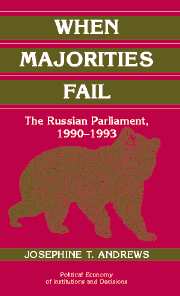Book contents
- Frontmatter
- Contents
- Acknowledgments
- 1 Introduction
- 2 Cycling in Action: Russia's Constitutional Crisis
- 3 Cycling and Its Consequences: A Theoretical Framework
- 4 Institutional Design and Implications for Majority Rule
- 5 Issue Dimensions and Partisan Alliances
- 6 The Structure of Preferences
- 7 Legislative Instability
- 8 The Dynamics of Agenda Control in the Russian Parliament
- 9 Implications of Disequilibrium in Transitional Legislatures
- References
- Index
7 - Legislative Instability
Published online by Cambridge University Press: 02 September 2009
- Frontmatter
- Contents
- Acknowledgments
- 1 Introduction
- 2 Cycling in Action: Russia's Constitutional Crisis
- 3 Cycling and Its Consequences: A Theoretical Framework
- 4 Institutional Design and Implications for Majority Rule
- 5 Issue Dimensions and Partisan Alliances
- 6 The Structure of Preferences
- 7 Legislative Instability
- 8 The Dynamics of Agenda Control in the Russian Parliament
- 9 Implications of Disequilibrium in Transitional Legislatures
- References
- Index
Summary
Essentially, I begin the book in Chapter 2 with a case study of the most important example of cycling in the Russian Parliament, the cyclical debate on the new Russian constitution. In my story, I emphasize just how seriously cycling disrupted debate on the constitution. Furthermore, I describe how it enabled the chairman to manipulate the agenda, using the problematic constitutional issue to keep deputies focused on reducing the powers of the executive branch. From this story, we know that cycling did occur in the Russian Parliament and that it occurred at precisely that moment when conditions in the parliament conformed to the conditions outlined by formal theory: Deputies were making complex choices involving several policy dimensions at once (i.e., the issue space was multidimensional), the number of partisan groups was large (greater than two), and legislative institutions (such as committees) were weak. The story in Chapter 2 also demonstrates that the impact of cycling was not trivial. It affected the legislature's ability to make collective decisions. It allowed the chairman to monopolize the agenda and thus keep the legislature focused on a power struggle with the executive branch, which in turn reduced the ability of either institution to function. Ultimately, cycling affected Russia's choice of constitutional system.
That said, we still do not know the answers to several questions. Was the cyclical debate on the draft constitution an isolated occurrence, or was the problem of cycling more extensive? Did cycling occur in sessions other than Session 4?
- Type
- Chapter
- Information
- When Majorities FailThe Russian Parliament, 1990–1993, pp. 183 - 223Publisher: Cambridge University PressPrint publication year: 2002



